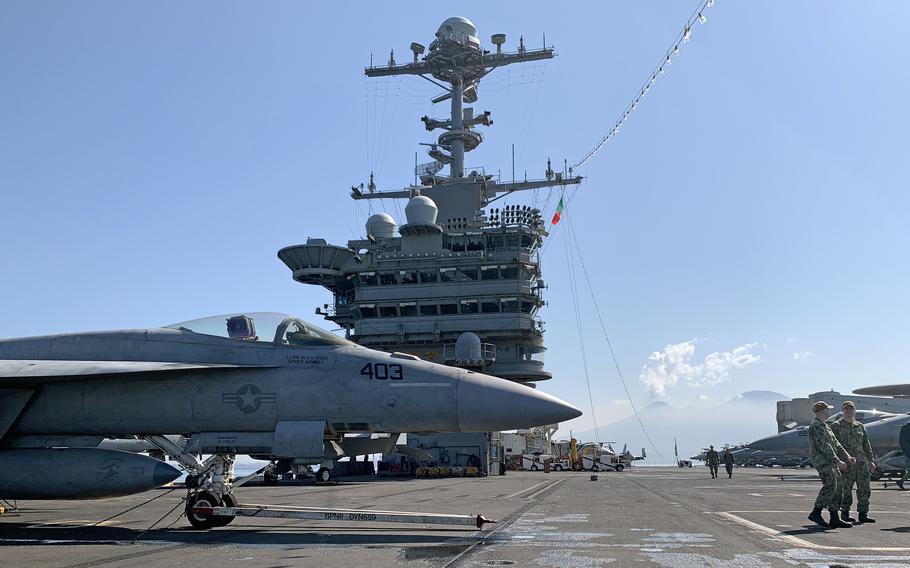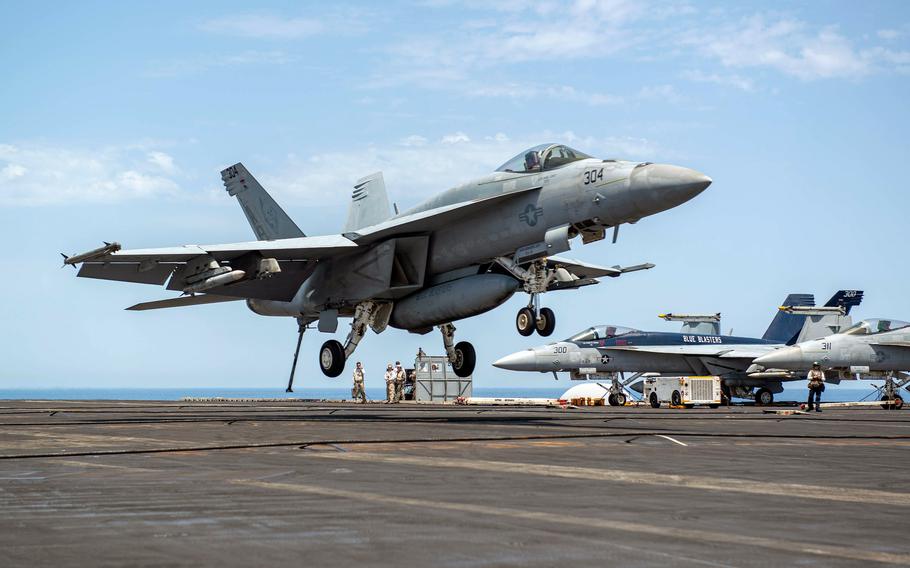
Aircraft are parked on the flight deck of the USS Harry S. Truman on May 11, 2022. No decision has yet been made on whether a Navy Super Hornet that was blown off the carrier’s deck two weeks ago in the Mediterranean Sea will be recovered. (Alison Bath/Stars and Stripes)
NAPLES, Italy — The decision to recover a Navy Super Hornet swept off an aircraft carrier into the Mediterranean Sea likely hinges on whether the plane carried technology that could be exploited by China or Russia, experts say.
The F/A-18 jet, introduced in 1999, is slowly being phased out of service. But newer, or Block III, versions have an infrared search-and-track system useful in pinpointing stealth aircraft. They also have better radar equipment and a precision approach landing system, experts say.
Obtaining such advanced technology could enable the Russians or the Chinese to “learn a good deal, both about countering specific U.S. capabilities and perhaps learning things they could develop and employ in their own aircraft,” said Jan van Tol, a retired Navy officer and senior fellow at the Washington, D.C.-based think tank Center for Strategic and Budgetary Assessments.
While not as sophisticated as the fifth-generation F-35 Lightning II stealth fighter, Super Hornets are “4.5-generation fighters, which means they would have some pretty sophisticated systems that the Russians or Chinese would be happy to get hold of,” van Tol said.
On July 10, the Navy announced that a Super Hornet assigned to Carrier Air Wing 1 had been blown off the deck of the USS Harry S. Truman two days earlier during heavy weather.
The statement didn’t identify the version of the plane involved or say whether a recovery effort was underway, saying only that a determination was being made.
No one was aboard the plane, although one sailor received minor injuries while doing an unrelated job.
It also was unclear exactly where the plane had sunk, but USNI News reported July 7 that the Truman was sailing in the Ionian Sea, which is south of the Adriatic Sea and bounded by Sicily, southern Italy, southern Albania and the western coast of Greece.
The deepest part of the Ionian Sea is 17,280 feet, according to worldatlas.com.

An F/A-18E Super Hornet lands on the flight deck of USS Harry S. Truman on June 15, 2022. No decision has yet been made on whether a Navy Super Hornet that was blown off the carrier’s deck two weeks ago in the Mediterranean Sea will be recovered. (Kelsey Trinh/U.S. Navy)
Since then, the Navy hasn’t made any announcements about the aircraft or potential recovery efforts. If a fifth-generation fighter were lost, the service would almost certainly seek to retrieve it.
When an F-35C fighter attempting to land on the USS Carl Vinson crashed and slipped into the South China Sea on Jan. 24, the Navy quickly announced it was working to find and recover the $103 million jet.
The plane was recovered about 37 days later from a depth of 12,400 feet. That operation included a remotely operated diving vehicle and crane from a diving support construction vessel, Stars and Stripes reported March 3.
Last fall, the first Block III Super Hornet was delivered to the Navy, according to a Sept. 27 statement from Boeing. The Navy plans to purchase 78 of the aircraft through the mid-2030s and upgrade its existing Block II Super Hornets with the same capabilities, according to Boeing.
It’s unclear exactly how many Block III Super Hornets the Navy has or how many existing planes have been upgraded.
Whether the F/A-18 lost July 8 remained intact or broke up, where it is located and how difficult a salvage operation would be are other factors the Navy would weigh, van Tol and other experts said.
Another factor would be how easily the Chinese or Russians could get to the aircraft, van Tol said.
Two Russian submarines carry deep-diving submersibles used for covert seabed missions, such as wreckage plundering or interference with undersea communication lines, according to a November USNI News report.
The Russians might look for the Super Hornet, but “it’s unlikely they will bring their undersea reconnaissance subs (to the Mediterranean) from the Northern Fleet, so it is unlikely Russia would find the plane,” said Bryan Clark, director of the Hudson Institute’s Center for Defense Concepts and Technology.
Any attempt by the Russians or Chinese to recover the jet would be visible to the U.S., and “we would likely initiate our own salvage operations and impede theirs,” van Tol added.
It seems that Navy leadership is debating whether it’s worth the trouble and expense of recovering the F/A-18, said James Holmes, who chairs the maritime strategy program at the Naval War College in Newport, R.I.
There was no doubt at all when it was “imperative not to let potential opponents get their hands on stealth technology, let alone all of the sensor and computer capabilities that make the F-35 what it is,” said Holmes.
He added that the Navy was being prudent in not releasing details about the F/A-18.